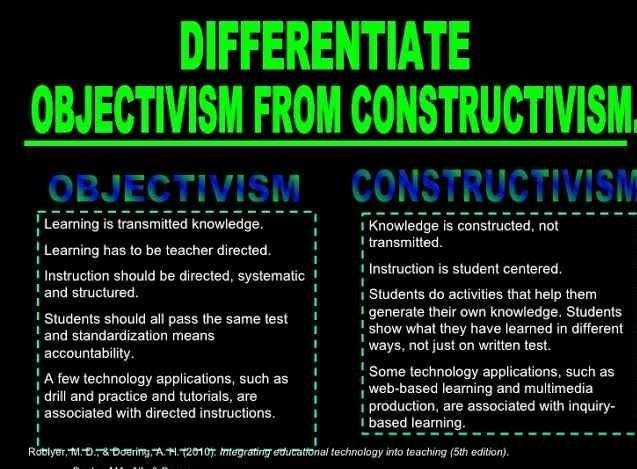 After reading the material, I thought that the models of assessment fit into either the Scientific Measurement Model or the Judgmental Model and that they were based on ideas of understanding intellectual capacities from an intelligence standpoint or a cognition standpoint. This made me think that there were just different ways of assessing knowledge and learning not necessarily different worldview. After reading the group discussions, it was brought up that assessment should stem from our worldview of knowing and learning. This was not a connection that I had made until it was explicitly stated in the discussion forum. And then I began to question whether I really knew the difference between Objectivism and Constructivism. I found the above figure and I thought it was a nice way to compare and contrast the two. What I'm wondering is what this figure would look like if we placed the two models of assessment from the article by Hager & Butler next to these.
After reading the material, I thought that the models of assessment fit into either the Scientific Measurement Model or the Judgmental Model and that they were based on ideas of understanding intellectual capacities from an intelligence standpoint or a cognition standpoint. This made me think that there were just different ways of assessing knowledge and learning not necessarily different worldview. After reading the group discussions, it was brought up that assessment should stem from our worldview of knowing and learning. This was not a connection that I had made until it was explicitly stated in the discussion forum. And then I began to question whether I really knew the difference between Objectivism and Constructivism. I found the above figure and I thought it was a nice way to compare and contrast the two. What I'm wondering is what this figure would look like if we placed the two models of assessment from the article by Hager & Butler next to these.
In the additional readings I learned that there were four practical Assessment Models:
- Evidence-Based
- Maximize student learning and outcomes
- Diagnostic
- Motivation
- Program Assessment
- communicate student achievement
- Competency-based
- long-term depends on credibility
- Validate assessment instrument
- set meaningful competency thresholds based on multiple sources of evidence
- External validity
- Performance based
- Ability to apply skills and knowledge
- Measures 1 or more course standards
- Complex
- Authentic
- Process Oriented
- Open-ended
- Time-bound
- Standard-based
- Students compared to standard all can reach
The New Assessment Models prepare for future learning
- Dynamic Assessment
- how well students can learn given resources
- Opportunity to produce novel structures
- Participatory Assessment
- situate theories
- Design Principles
- Value Added
- Measures teacher contribution
- Playful Assessment
- game based approach
- engagement or participation
One final idea that I struck me in reading one of the other discussion posts was to provide a whole group lesson, give students time to actively practice or collaborate, intervene, and then have them reflect. I really liked this structure.
